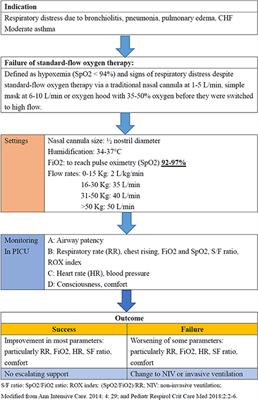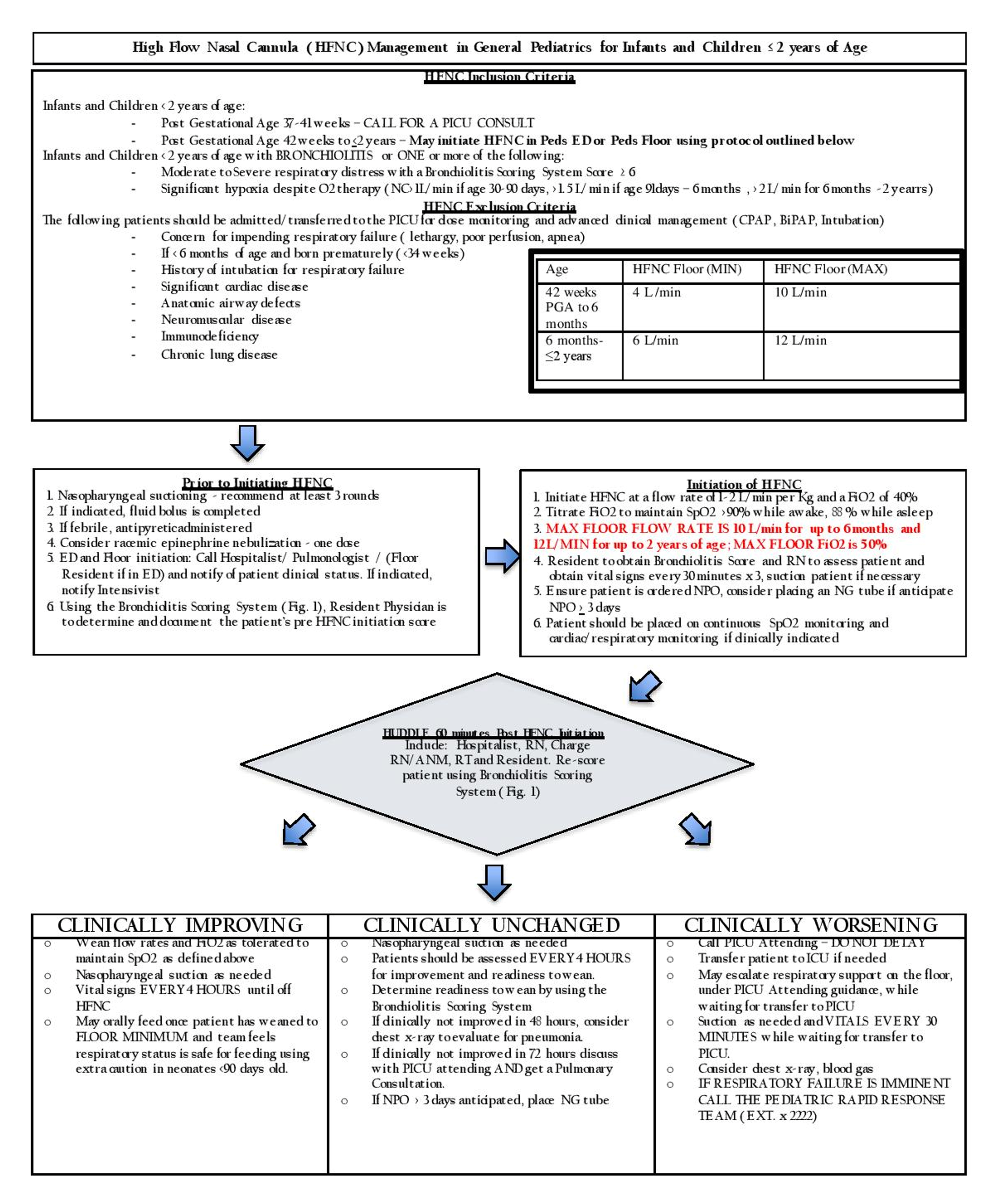high flow nasal cannula flow rate range
The median flow rate prior to the study was 5 range 3-8 Lmin and the fraction of inspired oxygen FiO 2 was 029 range 021-050. High flow nasal cannula is considered aerosolizing.

High Flow Nasal Cannula Oxygenation Utilization In Respiratory Failure European Journal Of Internal Medicine
Or median interquartile range.
. The use of nasal cannula adapted to the infants nares size to deliver heated and humidified gas at high flow rates has been associated with. Heart rate dyspnea score. High-flow nasal cannula HFNC oxygen therapy comprises an airoxygen blender an active humidifier a single heated circuit and a nasal cannula.
These younger adults were 23 females and 6 males all younger than 60. However the effects of HFNC in hypercapnic COPD are not well known. Meanwhile the inspiratory flow of patients with respiratory failure varies widely in a range from 30 to more than 100 Lmin.
High-flow nasal cannula HFNC therapy is an oxygen supply system capable of delivering up to 100 humidified and heated oxygen at a flow rate of up to 60 liters per minute. In addition oxygen therapy using high-flow gas also ensures a high inspiratory flow rate in patients with bronchial asthma as well as stable oxygen delivery. High-flow nasal cannula HFNC therapy is an oxygen supply system capable of delivering up to 100 humidified and heated oxygen at a flow rate of.
Flow rate for HFNP Therapy is the same for all patients regardless of medical condition. LOS length of stay. Given the ill-fitting nature and low flow rate there is a significant amount of room air entrainment hence the actual FiO2 delivery is much lower than 100.
The aim of this study was to assess retrospectively whether the average inspiratory flow velocity-based initial flow rate in high-flow nasal cannula HFNC therapy could be well tolerated and safely used for infants and children hospitalized with moderate to severe respiratory failure. Before NIV initiation the median interquartile range pH was 736 728737 with a PaCO2 of 51 4260 mmHg. The low-flow nasal cannula is an open system of supplementation with high levels of leaking air around the oxygen source.
Remain vigilant for signs. Start the high flow nasal cannula system in room air ie. As such the efficacy of treatment for the low-flow nasal cannula is limited.
The intubation rate among patients treated with HFNC was 80 and the mortality rate was 73 vs. A multicenter randomized controlled trial of a 3-Lkgmin versus 2-Lkgmin high-flow nasal cannula flow rate in young infants with severe viral bronchiolitis TRAMONTANE 2. The high flow.
The fraction of inspired oxygen Fi O 2 can be titrated from 21 to 100 independent of. High-flow nasal cannula HFNC is a relatively new device for respiratory support. There were no significant differences between the mean amplitude of the diaphragm EMG and the AEGMC and the number of bradycardias or desaturations between the three flow ratesConclusions.
Nasal prongs should not completely occupy the nares. High-Flow Oxygen Nasal Cannula HFNC Settings -Flow Rate 5 to 60 liters per minute - FiO2 021 to 10 - Initial Set Up Flow -may want to start at 20-35 liters per minute and titrate to to patients work of breathing WOB. Part 2 of the AIRVO 2 video is a step-by-step guide to setting up the AIRVO 2 and an introduction to our range of interfaces.
RhEnt rhinovirus or. Heat and humidified high flow nasal cannula or as most call it Hi Flow Nasal Cannula HFNC isnt just a standard nasal cannula cranked up to very high flow rates. Thirty-three patients without underlying diseases 22 males.
To use an objective metric of effort of breathing to determine optimal high flow nasal cannula HFNC flow rates in children rate product PRP an objective measure of effort of. HMNV human metapneumovirus. Once prescribed flow rate is reached assess requirement for supplemental oxygen.
It actually takes gas and can heat it to 37 o C with a 100 relative humidity and can deliver 021 100 fi02 at flow rates of up to 60 litersmin. Flow rates up to 60 liters per minute are delivered to the nasal cannula via a heated circuit. High Flow Nasal Cannula Basics.
267 in intubated patients. The efficacy of the COT method may be low due to insufficient oxygen content in the air. To no more than 15 Lmin.
Discussion In this meta-analysis based on 2851 patients from 25 studies hospitalized for COVID-19 intubation mortality and failure rates were 044 023 and 047 respectively. O O2 Flow rate range is from 5 to 60 Lminute set by flowmeter o FiO2 range is 21 to 100 on digital display Nursing care. Alternatively the flow rate may not meet the needs of patients conditions and hence the effect.
ROX index the ratio of SpO 2 FiO 2 to respiratory rate. HFNC high-flow nasal cannula. Airborne precautions should be used.
During simple nasal prong oxygen delivery unhumified 100 FiO2 oxygen is delivered at a set flow rate typically 2-6 lmin. A The high-flow nasal cannula circuit consists of a flow meter and oxygenair blender connected to a humidifier. How many liters can high flow nasal cannula.
SPTPes per minute was significantly lower with HFNC at 30 Lmin than 10 and 20 Lmin p 0001. The major reason for HFNC failure was pneumonia 45. High-flow nasal cannula HFNC may be an alternative method.
Another post-hoc analysis of adult ICU patients admitted with respiratory failure yielded quite the opposite result. All settings are controlled independently allowing for greater confidence in the delivery of supplemental oxygen as well as better outcomes when used. In pediatrics HFNC use continues to increase as the system is easily set up and is well tolerated by patients.
In infants with. HFNC high-flow nasal cannula. Allen Galek 2020 thoroughly analyzed the videofluoroscopic swallow study results of 29 healthy participants who were on high-flow nasal cannula airflow settings of 10 20 30 40 50 and 60 lpm in randomized and blinded order presentations.

Frontiers High Flow Nasal Cannula Therapy In Children With Acute Respiratory Distress With Hypoxia In A Pediatric Intensive Care Unit A Single Center Experience Pediatrics

Pdf Association Between High Flow Nasal Cannula And End Expiratory Esophageal Pressures In Premature Infants Semantic Scholar

40 Vs 60 L Min What S The Difference Between Vapotherm High Velocity Therapy And High Flow Nasal Cannula Vapotherm

What Is A High Flow Nasal Cannula Hfnc

Initial Or Starting Flows Of High Flow Nasal Cannula In A Pediatric Download Table

How Does High Flow Nasal Cannula Hfnc Work Medmastery

Florali 2 Non Invasive Ventilation Niv Vs High Flow Nasal Cannula Hfnc As Pre Oxygenation Prior To Intubation Rebel Em Emergency Medicine Blog

Characteristics And Outcome Of High Flow Nasal Cannula Episodes Download Table

The Evidence For High Flow Nasal Cannula Devices In Infants Semantic Scholar

Nasal Cannula Cpap And High Flow Nasal Cannula Effect Of Flow On Temperature Humidity Pressure And Resistance Semantic Scholar

Cureus The Use Of High Flow Nasal Cannula And The Timing Of Safe Feeding In Children With Bronchiolitis

Study Flow Chart Gf Gas Flow If Inspiratory Flow Hfnc High Flow Download Scientific Diagram

Oxygenation Parameters And Respiratory Rate In High Flow Nasal Cannula Download Table

High Flow Nasal Cannula Versus Conventional Oxygen Therapy In Relieving Dyspnea In Emergency Palliative Patients With Do Not Intubate Status A Randomized Crossover Study Annals Of Emergency Medicine

How Does High Flow Nasal Cannula Hfnc Work Medmastery
High Flow Nasal Cannula For Adult

High Flow Nasal Cannula Oxygen Therapy And Hypoxia During Gastroscopy With Propofol Sedation A Randomized Multicenter Clinical Trial Gastrointestinal Endoscopy
